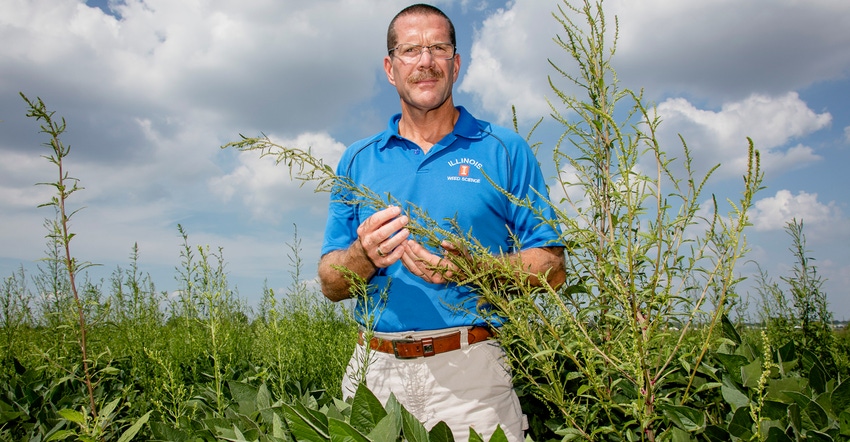
Aaron Hager, University of Illinois weed scientist, says if you asked him five years ago for the top five ways non-native Palmer amaranth could come into the state of Illinois, the Conservation Reserve Program likely wouldn’t have occurred to him.
Yet commercial seed packages for pollinator habitat, along with other methods of introduction, have brought the “potentially devastating” southern weed to counties ranging from Stephenson, which borders Wisconsin to the north, to Massac, which borders Kentucky to the south.
Palmer amaranth — the fastest growing and most competitive of the Amaranthus weed species — has spread to dozens of counties in Illinois. Researchers have confirmed resistance to ALS inhibitors, glyphosate and PPO inhibitors in the state.
In southern Kansas, researchers recently confirmed 2,4-D and dicamba resistance in Palmer amaranth — underscoring the fact that few effective postemergence herbicide options remain in the area for one of the most difficult-to-control and economically damaging broadleaf weeds in the U.S.
An infestation can reduce corn and soybean yield to nearly zero, and while the more resistant Kansas population is far removed from Illinois, Hager says Illinois populations will inevitably develop the same resistances.
“Whether the seeds come to Illinois with resistance or whether they developed resistance here through selection pressure isn’t what’s important. What’s important is remaining vigilant and identifying Palmer populations early,” Hager says. “With resistance, there’s no ‘if it’s going to happen’ — it’s when.”
The Palmer amaranth population studied by Kansas State University has an eight- to tenfold resistance to 2,4-D compared to a susceptible population. When sprayed with the recommended rate of dicamba, the researchers report the resistant progeny of Palmer amaranth showed an 81% rate of survival.
“This is yet another example of how weeds, when subjected to a sufficient amount of selection pressure, continue to adapt to the tools that we use to try to control them. It’s no big surprise,” Hager says. “To just open up a different jug of herbicide — that’s a very short-term solution. And it’s not one that’s sustainable.”

TAKING OVER: Studies have found that Palmer amaranth can take over fields in as few as three years.

Hager recommends spraying the weed before it’s 4 inches tall, as herbicide efficacy is reduced well before flowering. He says physically removing plants before seeds become viable will pay returns on the time investment for years into the future.
“If you let one or two plants survive and then you run these $350,000 weed seed spreaders through that field that we call combines, that’s how you start streaking these fields with these resistant populations,” Hager says, adding that as the weed seed bank grows, farmers run a greater chance of selecting for resistance.
Lessons from another amaranth
Waterhemp is also a member of the Amaranthus genus, commonly referred to as pigweed, so insights gained from fighting waterhemp in Illinois can also be applied to Palmer amaranth. Hager says he has a 2,4-D-resistant population of waterhemp in Champaign County, and when he went back and looked through the records for that field, he couldn’t find evidence that 2,4-D had ever been sprayed there.
“Yet this population is resistant to 2,4-D, and for about the first two years that we worked on that field, the dicamba treatments performed about as we would expect: good, but not excellent like glyphosate used to be,” he says. “But now, for the last two growing seasons, we have consistently seen an increase in the frequency of the plants that survived dicamba treatment.”
He says that without good stewardship, dicamba will be a short-lived product in the fight against both waterhemp and Palmer amaranth. And contrary to some growers’ hopes, it doesn’t matter how herbicide is applied when it comes to resistance. He points to Group 15 herbicides, which are primarily soil-applied, and newly discovered resistance in waterhemp on fields in Champaign and McLean counties.
“Resistance evolves regardless of how herbicide is applied,” Hager concludes. “You’ll easily notice when a foliar-applied herbicide fails, but the way resistance to soil-applied products manifest is that the length of residual control just gets less and less and less.”
About the Author(s)
You May Also Like




